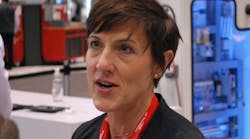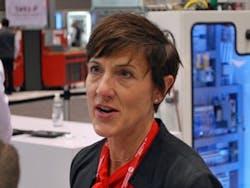“As a company, we’re trying to enable such changeovers with the touch of a button. From a configuration perspective, they shouldn't require any manual intervention.” Rockwell Automation’s Stephanie Wilterhalter explains how digital technology and smarter devices and systems are helping machine builders to differentiate their offerings.
Digital tools are available to enhance the design and operation of machinery and equipment lines in manufacturing facilities. These technologies are available to help OEMs and end users to ramp up production quickly and sustain it with the barest of downtime and unplanned interruptions.
With so many options, the challenge comes in cobbling these tools together to create a singular solution that fits the needs of the OEM and its customer. But at Rockwell Automation’s Integrated Architecture booth on display at Automation Fair 2019 this week in Chicago, a piece of equipment from Trinks, a 100-year-old OEM from Wisconsin, offers an example of how the technologies work in unison to create a real-world solution.
“We wanted to showcase our end-to-end solutions—simulation, selection, design, configuration—and how our customers can incorporate the technologies of the portfolio and deliver them through smart machines to get to production faster and operate longer because they’re getting actionable information for faster decisions,” said Stephanie Winterhalter, global portfolio marketing manager, Rockwell Automation.
“Our OEMs are trying to figure out how to help their customers,” she explained. “We start with our digital-twin software, Emulate3D. You can prove out your machine before you build it, and you can test out your control system, too.”
Application Code Manager and Machine Builder libraries give OEMs reusable code to design the machines without starting from scratch.
“A lot of times OEMs will build and configure 80% of the equipment and then finish the final 20% onsite,” explained William Martin, program manager, networked components, Rockwell Automation. “Even the graphics for our HMIs [human-machine interfaces] are copy-and-paste faceplates.”
That plug-and-play technology starts with design and build, but carries on to modifications and changeovers, as well.
“With automatic device configuration, if something fails, maintenance can swap it out in six minutes or less,” said Winterhalter. “The data transfer is automatic. As a company, we’re trying to enable such changeovers with the touch of a button. From a configuration perspective, they shouldn't require any manual intervention any more.”
Machine smarts
The exodus of baby boomers and widespread skills shortages have put a strain on manufacturers’ abilities to monitor equipment and remediate issues. “The end users of the machines are losing tribal knowledge,” said Martin. “They need to bring in a smarter machine. Ideally they want to automatically identify a troublesome device and swap it out quickly.”
Motor control, sensing and safety are among the key deliverables of Rockwell Automation’s Integrated Architecture—and the company is making all of them smarter.
“For intelligent motor control, instead of on/off commands, we can provide more information on the motor,” said Martin, who cited the ability to measure the load on the motor as a means to measure the fill level that turns off a pump, for example.
“We can also do some proactive diagnostics,” explained Martin. “For example, at 950,000 operations, you might reach a limit. In the past, they didn’t count operations; they just waited until the device failed.” With smart technology, a user can measure how much of a device’s useful life remains.
Similar to intelligent motor controls, smart sensing can eliminate a variety of manual remediations. “Our smart sensors are on IO-Link,” said Martin. “We can do diagnostics and the PLC can house the configuration data. You can change out a faulty sensor on the fly, and the PLC automatically senses the presence of a new sensor and configures it.”
Finally, smart safety entails the expected functional safety, but GuardLink technology, the safety-based communications protocol, hooks them all up together. GuardLink allows the delivery of device information and diagnostics, advanced functionality and flexibility.
Intelligent operations
The Trinks machinery in the Integrated Architecture booth offers a look into the application of tools, capabilities and technologies.
While larger, multibillion-dollar enterprises can implement this automation and standardize on it to realize benefits in global operations, smaller OEMs and end users can also reap the benefits and value.
“It demonstrates the scalability,” said Winterhalter. “We’re partnering with other digital companies and technologies, and we’re giving OEMs more options. They can create more value for themselves. Trinks recognized it needed to do something more efficient. Trinks’ industry is mature. New technologies give them a competitive advantage.”
Finally, operation begets maintenance and repair at some point. “You get some notification, and then you use tools such as augmented reality (AR) to look at it and see what’s going on,” explained Winterhalter.
“For augmented reality, one can use a tablet or HoloLens,” said Martin. “The information pops up. For example, you see that there’s an overload trip and you don’t know which one, but the AR can help with that, too.”
The editors of Control are on-site at Automation Fair 2019 to bring you breaking news, innovations and insights from the event. Once the event is over, they will put together a report featuring the top news. Pre-order your copy today.






